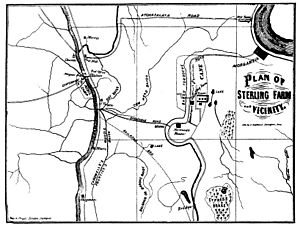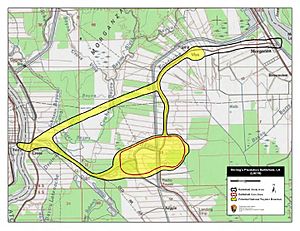Battle of Stirling's Plantation facts for kids
Quick facts for kids Battle of Stirling's Plantation |
|||||||
|---|---|---|---|---|---|---|---|
| Part of the American Civil War | |||||||
|
|||||||
| Belligerents | |||||||
| Commanders and leaders | |||||||
| Napoleon J. T. Dana Joseph B. Leake |
Thomas Green | ||||||
| Units involved | |||||||
| XIII Corps | Atchafalaya River forces | ||||||
| Strength | |||||||
| 650 | 3,000 | ||||||
| Casualties and losses | |||||||
| 16 killed 45 wounded 454 captured |
26 killed 85 wounded 10 missing |
||||||
The Battle of Stirling's Plantation (also known as the Battle of Fordoche Bridge) was a fight during the American Civil War. It happened on September 29, 1863, in Pointe Coupee Parish, Louisiana. In this battle, Confederate forces won against a smaller Union group.
Contents
Why the Battle Happened
After the Siege of Vicksburg, a Union Army group, led by Francis J. Herron, moved to Louisiana. They became part of the 13th Corps. Their goal was to distract Confederate soldiers. This would help a larger Union plan to invade Texas.
Union Major General Nathaniel P. Banks wanted to send troops into Texas. Herron's division was sent to Morganza, Louisiana. This area was near the Atchafalaya River. Confederate forces, led by Brigadier General Tom Green and Alfred Mouton, were also active there. The Union hoped their presence would stop the Confederates from moving to Texas.
On September 5, Herron's soldiers traveled up the Mississippi River. They landed near Morganza on September 7. The next day, they marched through Morganza. They reached the Atchafalaya River and then camped near a place called Fordoche.
Setting Up Camp
On September 11, General Herron decided to send a smaller group back to the Fordoche Bridge. This group would watch for Confederate activity. Joseph Bloomfield Leake, a Lieutenant Colonel, was put in charge. His group included soldiers from:
- The 19th Iowa Volunteer Infantry Regiment
- The 26th Indiana Infantry Regiment
- A part of the Battery B, 1st Missouri Light Artillery (cannons)
- A group from the 6th Missouri Volunteer Cavalry (horseback soldiers)
They also had a special company of mounted infantry. These were foot soldiers who rode horses. The Union soldiers soon met Confederate pickets (guards). They had small fights as they moved. They camped at Norwood's plantation. This area was about six miles from the Atchafalaya River.
Leake realized his position at Norwood's was not safe. There were many old roads nearby. These roads could let Confederates sneak up behind them. Confederate General Mouton saw this as a chance to attack Leake's small force.
On September 15, Leake heard that an attack was coming. He moved his camp two miles north to the Stirling plantation. This spot was better, but still had problems. Roads still allowed Confederates to move around them easily.
A raised bank (levee) ran along the road at Stirling plantation. Leake had a gap cut in it for his cannons. Union guards were always on duty. But the force was small, and the soldiers felt uneasy.
Confederate soldiers were seen more and more often. They were between Stirling's and Morganza. General Herron knew about this but did not protect Leake's group from behind. Herron was sick. On September 28, he gave command to Napoleon J.T. Dana and left for New Orleans.
Confederate Attack Plan
General Mouton decided to attack Leake's small force. On September 19, he ordered General Green to plan the attack. The final decision was made on September 25. Green had 3,000 soldiers. They began crossing the Atchafalaya River by ferry on September 28. The weather was very rainy.
On the morning of September 29, Mouton's and Speight's brigades (large groups of soldiers) moved through woods and swamps. They aimed to block any Union help coming from Morganza. Speight's brigade would attack Leake's right side and rear.
The rest of the Confederate cavalry (horseback soldiers) marched toward the Fordoche Bridge. They arrived around 11:00 AM. They started fighting with Union cavalry guards there. About 30 minutes later, more gunshots were heard from the Stirling farm.
The Battle Begins
Just before noon, a shot was heard from the Union guard post north of Stirling's camp. More shots came from the cane fields. This meant Mouton's attack had begun. Leake ordered his cannons to the gap in the levee. They were supposed to fire across the cane fields.
The 19th Iowa Volunteer Infantry Regiment was ordered to a fence behind the house. They began firing. The 26th Indiana Infantry Regiment was placed to their left. They were told to fire sideways.
For some reason, the cannons did not reach the gap. Soldiers had to move them by hand among the buildings. This made them useless.
Leake had only 450 foot soldiers available. Many were on guard duty. Both the 19th Iowa and 26th Indiana were pushed back. They moved through the Stirling buildings. Then they took a new position on the levee. The levee acted like a strong wall.
The Confederates had many more soldiers. They tried to go around the right side of the 19th Iowa. The 26th Indiana was moved to the 19th's right. The Confederates then moved to their right. They poured through the gap in the levee. They tried to get around the left side of the 19th Iowa.
The weather was hot, and the soldiers were tired. Leake was shot in the foot. He fell off his horse and was captured. Because of the confusion, no other officer took command.
Meanwhile, the Confederate cavalry had completely defeated the Union cavalry to the south. The Union cavalry rode away quickly toward Morganza. None of them were captured. They passed east of the Stirling plantation. The Union foot soldiers at Stirling's were so busy fighting that they did not know what happened to their cavalry.
Many of Green's cavalry soldiers wore Union uniforms. These had been captured earlier. When the Union cavalry ran away, Green's column advanced up the road. They came from Norwood's to the Stirling plantation. The Union foot soldiers saw them coming. They thought it was their own 6th Missouri cavalry. Only when they were fired upon did they realize it was Green's cavalry attacking their other side.
The Union soldiers were greatly outnumbered. They had no leader. They were attacked from all sides. So, the Union soldiers surrendered bit by bit.
What Happened Next
Only a few Union foot soldiers managed to escape. The Union side lost 16 soldiers killed, 45 wounded, and 454 captured. The Confederates lost 26 killed, 85 wounded, and 10 missing.
The Confederates also captured:
- Two cannons
- Two new ambulances
- One hospital wagon full of medical supplies
- All the weapons from the captured Union soldiers
Green quickly gathered his prisoners and captured items. He moved back to the river and crossed it fast. The prisoners were then marched to the Camp Ford prison camp in Tyler, Texas. They arrived there on October 23, 1863.




